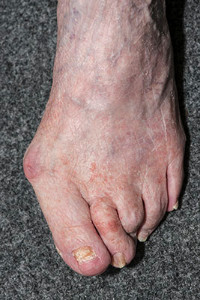 According to a surgeon on the medical staff of Lee Health, “The term bunion really implies a bump on the inside portion of the foot just behind the big toe joint.” Bunions are extremely common and some people are at a higher risk of developing them compared to others. Podiatrists say that people with flat feet are more likely to develop bunions than those with normal arches in their feet. Many podiatrists have come to the realization that bunion removal surgery isn’t very effective for those with flat feet, because the arch in the foot needs to be corrected in order to prevent more bunions from developing in the future.
According to a surgeon on the medical staff of Lee Health, “The term bunion really implies a bump on the inside portion of the foot just behind the big toe joint.” Bunions are extremely common and some people are at a higher risk of developing them compared to others. Podiatrists say that people with flat feet are more likely to develop bunions than those with normal arches in their feet. Many podiatrists have come to the realization that bunion removal surgery isn’t very effective for those with flat feet, because the arch in the foot needs to be corrected in order to prevent more bunions from developing in the future.
If you are suffering from bunions, contact Dr. Lubrina Bryant of District Podiatry, PLLC. Our doctor can provide the care you need to keep you pain-free and on your feet.
What Is a Bunion?
A bunion is formed of swollen tissue or an enlargement of boney growth, usually located at the base joint of the toe that connects to the foot. The swelling occurs due to the bones in the big toe shifting inward, which impacts the other toes of the foot. This causes the area around the base of the big toe to become inflamed and painful.
Why Do Bunions Form?
Genetics – Susceptibility to bunions are often hereditary
Stress on the feet – Poorly fitted and uncomfortable footwear that places stress on feet, such as heels, can worsen existing bunions
How Are Bunions Diagnosed?
Doctors often perform two tests – blood tests and x-rays – when trying to diagnose bunions, especially in the early stages of development. Blood tests help determine if the foot pain is being caused by something else, such as arthritis, while x-rays provide a clear picture of your bone structure to your doctor.
How Are Bunions Treated?
If you have any questions, please feel free to contact our office located in Washington, D.C . We offer the newest diagnostic and treatment technologies for all your foot care needs.
Read more about Bunions